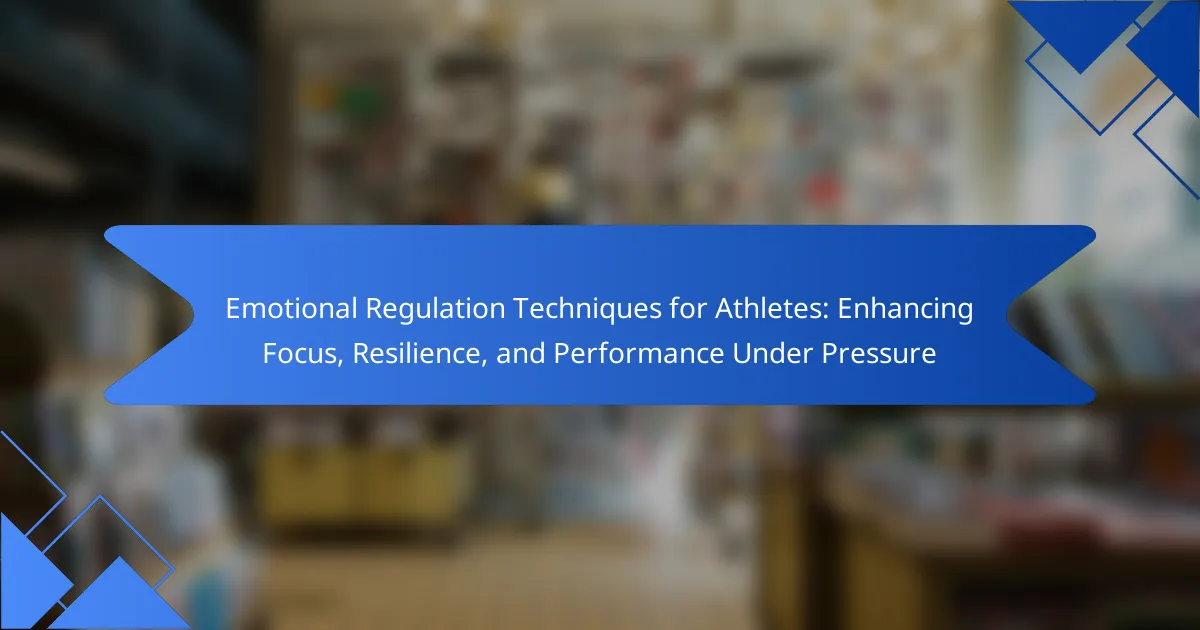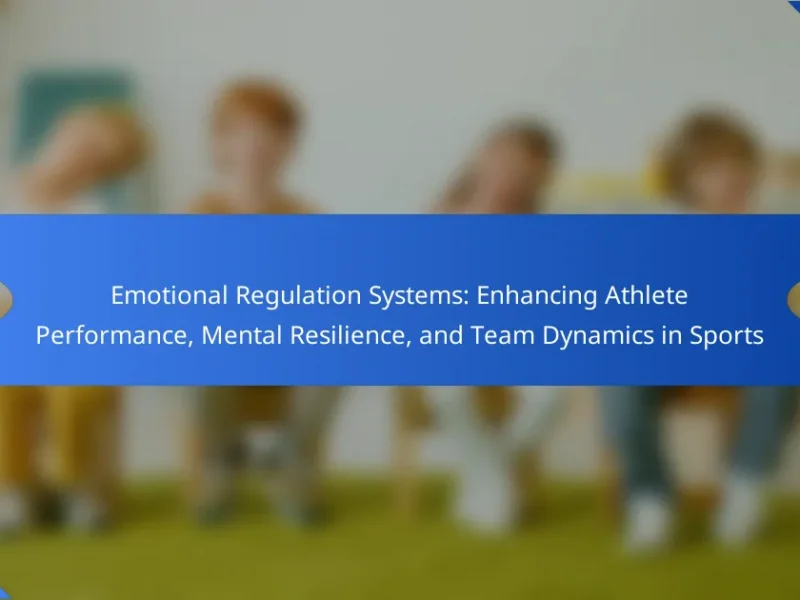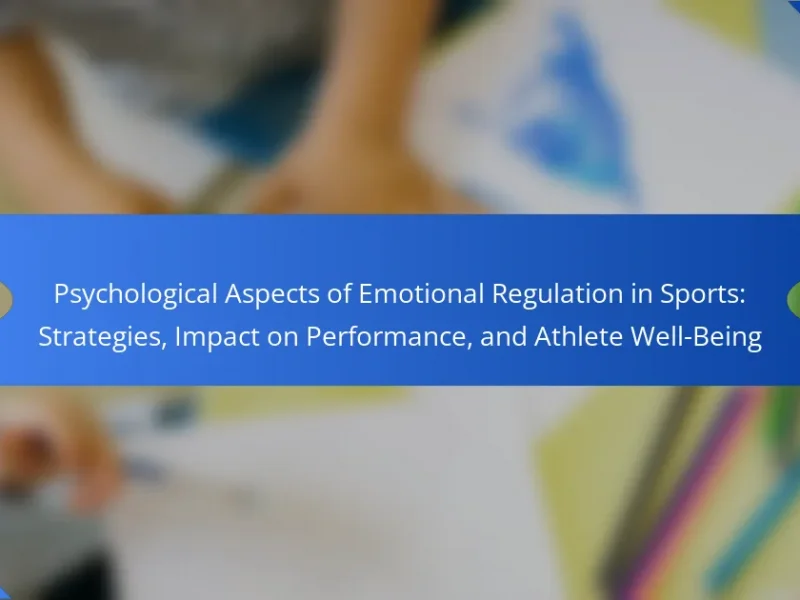Emotional regulation techniques for athletes enhance focus, resilience, and performance under pressure. Key strategies include mindfulness practices, cognitive restructuring, and breathing exercises. These methods help manage stress, improve present-moment awareness, and foster a positive mindset. Consistent implementation of these techniques can lead to better athletic performance and mental well-being.
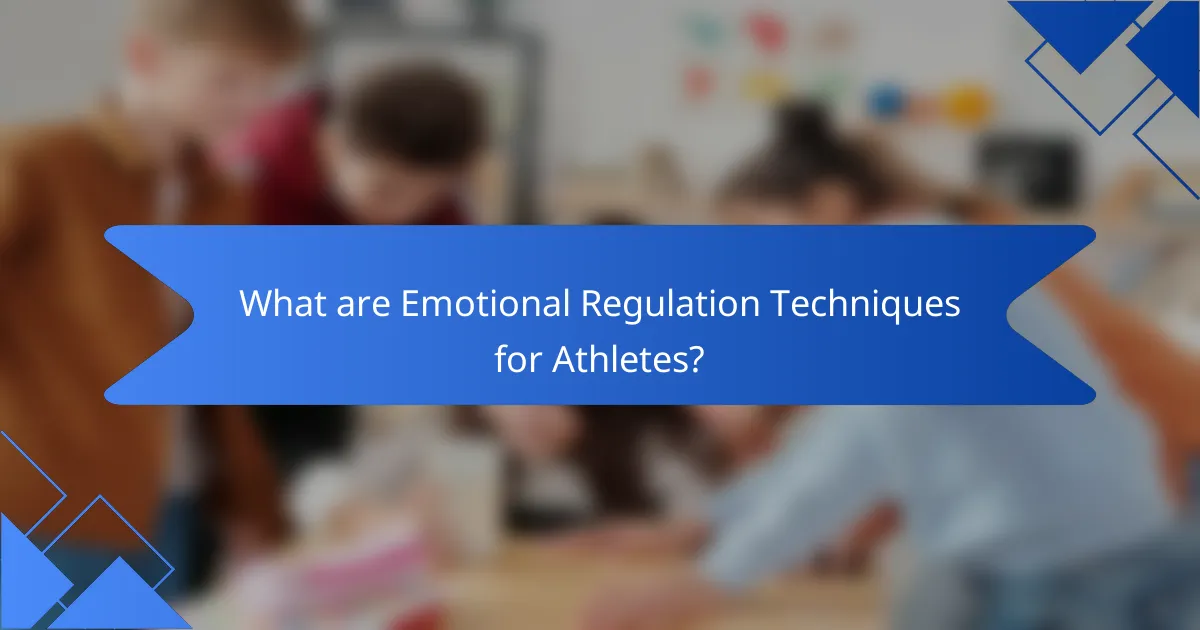
What are Emotional Regulation Techniques for Athletes?
Emotional regulation techniques for athletes enhance focus, resilience, and performance under pressure. Techniques such as mindfulness, cognitive restructuring, and breathing exercises help athletes manage stress and emotions effectively. Mindfulness improves present-moment awareness, allowing athletes to concentrate better during competitions. Cognitive restructuring helps in reframing negative thoughts, fostering a positive mindset. Breathing exercises regulate physiological responses, reducing anxiety and promoting calmness. Implementing these techniques consistently can lead to improved athletic performance and mental well-being.
How do these techniques enhance focus and performance?
Emotional regulation techniques enhance focus and performance by fostering mental clarity and reducing anxiety. These techniques, such as mindfulness and visualization, help athletes maintain composure under pressure. Research shows that athletes employing these strategies experience improved concentration, allowing for better decision-making during competitions. Additionally, emotional regulation contributes to resilience, enabling athletes to recover swiftly from setbacks and maintain peak performance levels.
What role does resilience play in sports performance?
Resilience significantly enhances sports performance by enabling athletes to maintain focus and adapt under pressure. It allows them to recover quickly from setbacks and manage stress effectively. Techniques such as visualization, mindfulness, and positive self-talk foster resilience, improving overall mental strength. Research indicates that resilient athletes often perform better in high-stakes situations, showcasing greater consistency and determination. Developing resilience not only aids in performance but also contributes to long-term athlete well-being.
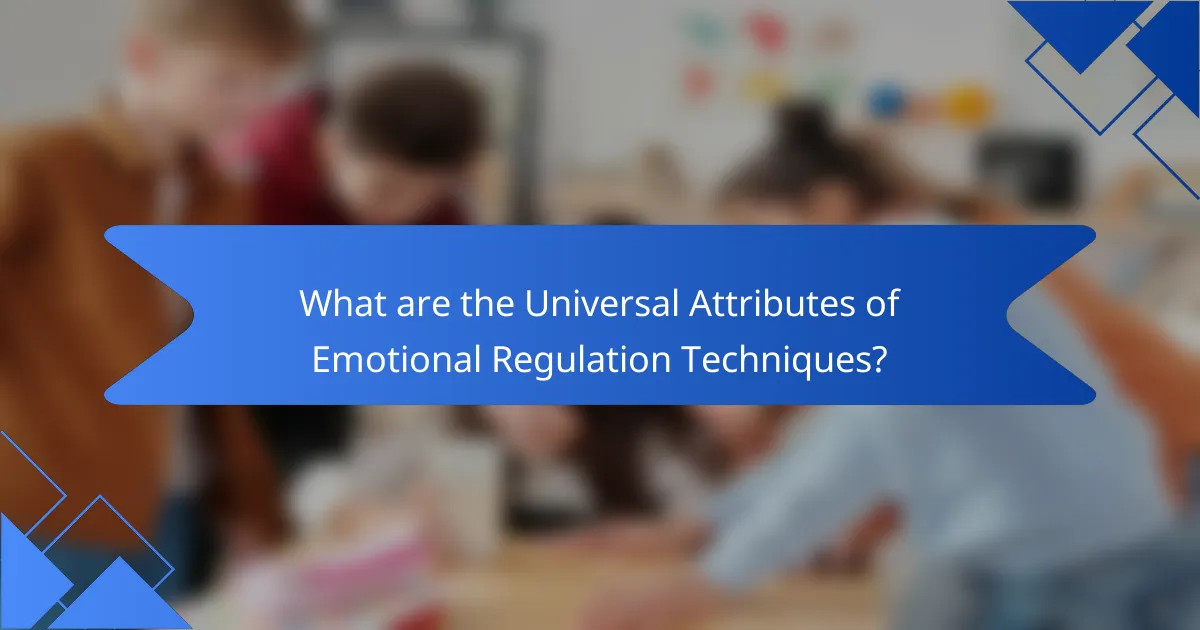
What are the Universal Attributes of Emotional Regulation Techniques?
Emotional regulation techniques for athletes universally enhance focus, resilience, and performance under pressure. Key attributes include mindfulness practices, cognitive restructuring, and breathing exercises. Mindfulness improves present-moment awareness, fostering emotional control. Cognitive restructuring allows athletes to reframe negative thoughts, promoting a positive mindset. Breathing exercises help manage physiological responses to stress, enhancing overall performance. These techniques collectively contribute to improved emotional stability, critical for success in high-pressure situations.
How do breathing exercises improve emotional control?
Breathing exercises enhance emotional control by promoting relaxation and reducing stress. These techniques help athletes manage anxiety, improve focus, and increase resilience under pressure. By regulating breath, individuals can activate the parasympathetic nervous system, leading to a calming effect. This process aids in emotional regulation, allowing athletes to respond rather than react to stressors. Regular practice of breathing exercises can significantly enhance overall performance and mental clarity during competitions.
What is the impact of visualization on performance?
Visualization significantly enhances athletic performance by improving emotional regulation, focus, and resilience. Athletes who practice visualization techniques report increased confidence and reduced anxiety, leading to better execution under pressure. Research indicates that visualization can activate neural pathways similar to actual performance, enhancing muscle memory and readiness. This mental rehearsal allows athletes to prepare for various scenarios, fostering adaptability and concentration during competitions.
How does self-talk influence athlete mindset?
Self-talk significantly influences athlete mindset by shaping emotional regulation. Positive self-talk enhances focus, builds resilience, and improves performance under pressure. Research indicates that athletes who engage in constructive self-talk experience reduced anxiety and increased confidence. This mental strategy serves as a unique attribute of successful athletes, allowing them to maintain composure and clarity during competitions. As a result, effective self-talk contributes to improved outcomes and overall athletic success.
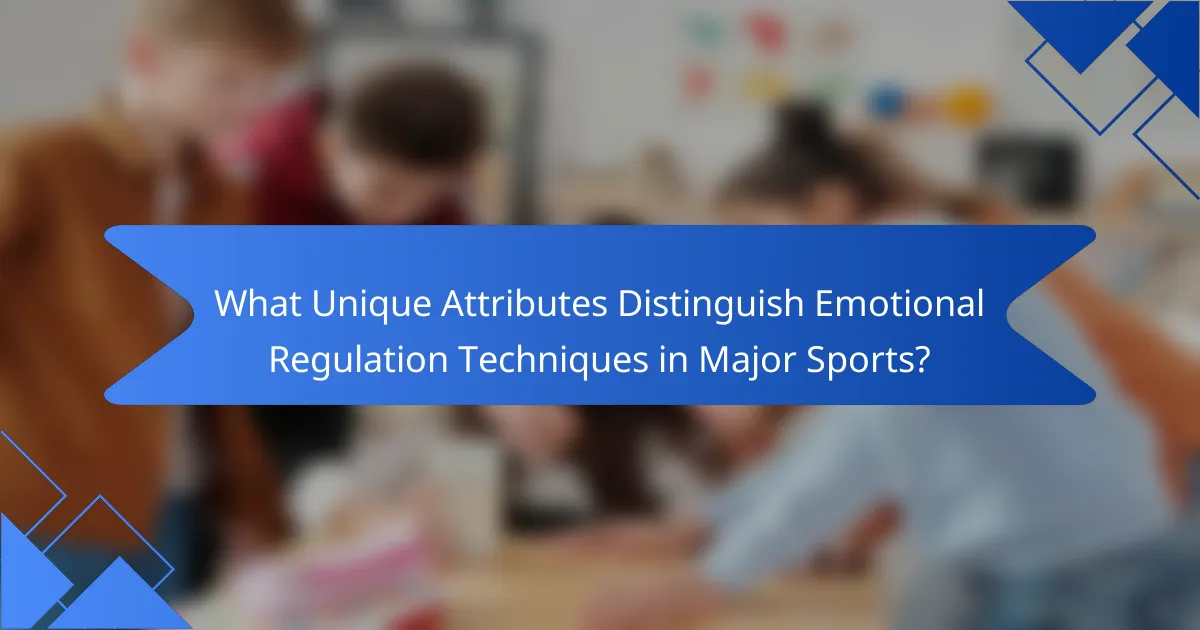
What Unique Attributes Distinguish Emotional Regulation Techniques in Major Sports?
Unique attributes of emotional regulation techniques in major sports include tailored strategies, real-time adaptability, and sport-specific applications. Tailored strategies focus on individual athlete needs, enhancing effectiveness. Real-time adaptability allows athletes to modify techniques during competition, improving resilience and focus. Sport-specific applications ensure techniques align with the demands of each sport, maximizing performance under pressure.
How do sport-specific strategies differ in emotional regulation?
Sport-specific strategies for emotional regulation vary significantly based on the demands of the sport. Techniques are tailored to enhance focus, resilience, and performance under pressure.
For example, team sports often emphasize collective emotional management, fostering communication and support among players. In contrast, individual sports may focus on self-regulation techniques, such as visualization and mindfulness, to maintain composure.
Additionally, high-intensity sports require rapid emotional adjustments, utilizing techniques like breathing exercises to regain focus quickly. Endurance sports may prioritize long-term emotional strategies, promoting mental endurance through goal-setting and self-talk.
Understanding these differences is crucial for athletes to adopt the most effective emotional regulation techniques for their specific sport.
What are the benefits of team-based emotional regulation practices?
Team-based emotional regulation practices enhance athletes’ focus, resilience, and performance under pressure. These techniques foster collaboration, improve communication, and create a supportive environment. As a result, athletes experience reduced anxiety, increased motivation, and better emotional control during competitions. Studies show that teams utilizing these practices report higher overall performance metrics and improved individual player outcomes. Implementing structured emotional regulation strategies can lead to lasting benefits in team dynamics and competitive success.

What are the Rare Attributes of Emotional Regulation Techniques?
Mindfulness practices enhance self-awareness and emotional insight. Cognitive restructuring techniques help athletes reframe negative thoughts. Visualization strategies improve focus and emotional control during performance. Biofeedback methods provide real-time data on emotional states, aiding in self-regulation. These rare attributes contribute to a comprehensive approach to emotional regulation in sports.
How can biofeedback be utilized for emotional regulation?
Biofeedback can enhance emotional regulation for athletes by providing real-time data on physiological responses. This technique helps athletes recognize and control their stress, anxiety, and focus levels, leading to improved resilience and performance under pressure. By using biofeedback devices, athletes can learn to modify their heart rate, muscle tension, and breathing patterns, resulting in a unique ability to manage emotions effectively. Regular practice can lead to significant improvements in overall mental well-being and competitive performance.
What experimental techniques are emerging in emotional regulation?
Emerging experimental techniques in emotional regulation for athletes focus on mindfulness practices, biofeedback, and cognitive restructuring. Mindfulness enhances present-moment awareness, fostering resilience under pressure. Biofeedback utilizes technology to monitor physiological responses, allowing athletes to regulate emotions effectively. Cognitive restructuring helps athletes reframe negative thoughts, promoting a positive mindset. These techniques collectively enhance focus and performance.
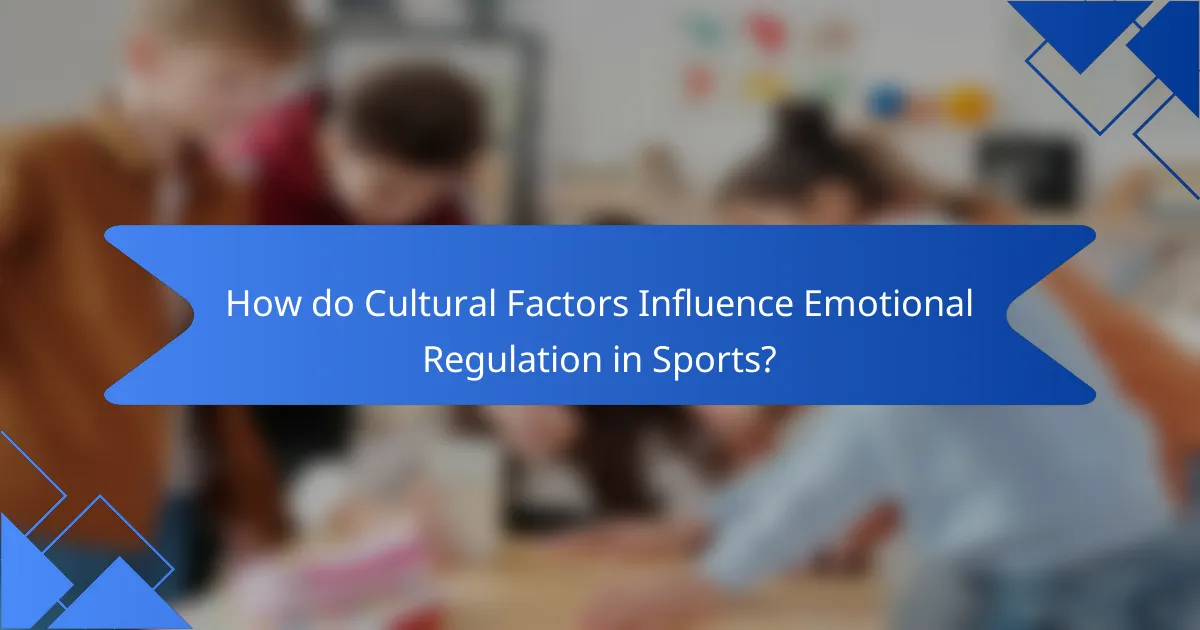
How do Cultural Factors Influence Emotional Regulation in Sports?
Cultural factors significantly influence emotional regulation techniques in sports by shaping athletes’ responses to pressure. Different cultures prioritize various values, such as collectivism or individualism, which affect how athletes manage stress and maintain focus.
For instance, athletes from collectivist cultures may emphasize team harmony, leading to emotional regulation strategies that foster group cohesion. In contrast, individualistic cultures often encourage self-reliance, prompting athletes to adopt personal coping mechanisms.
Research indicates that cultural context can impact resilience, with athletes trained in environments that value perseverance displaying enhanced emotional control. This adaptability is crucial for performance under pressure, as it allows athletes to navigate stressors effectively.
Understanding these cultural influences enables coaches and sports psychologists to tailor emotional regulation techniques, enhancing athlete performance and mental well-being.
What regional differences exist in emotional regulation practices?
Regional differences in emotional regulation practices for athletes can significantly impact performance. For instance, athletes in East Asian cultures often emphasize collective emotional control, while Western athletes might focus on individual expression. Cultural norms shape techniques such as mindfulness, cognitive restructuring, and emotional expression. In Japan, athletes may practice meditation to enhance focus, whereas American athletes might engage in open discussions about feelings to build resilience. These variations highlight how cultural context influences emotional regulation strategies in sports.
How do cultural attitudes towards mental health affect athletes?
Cultural attitudes towards mental health significantly impact athletes’ emotional regulation techniques. Acceptance of mental health issues fosters resilience and enhances performance under pressure. In cultures that prioritize mental well-being, athletes are more likely to seek help, use emotional regulation strategies, and achieve optimal focus. Conversely, stigma can lead to avoidance of mental health resources, hindering performance. Encouraging open discussions about mental health can empower athletes to develop coping mechanisms, ultimately improving their overall performance.
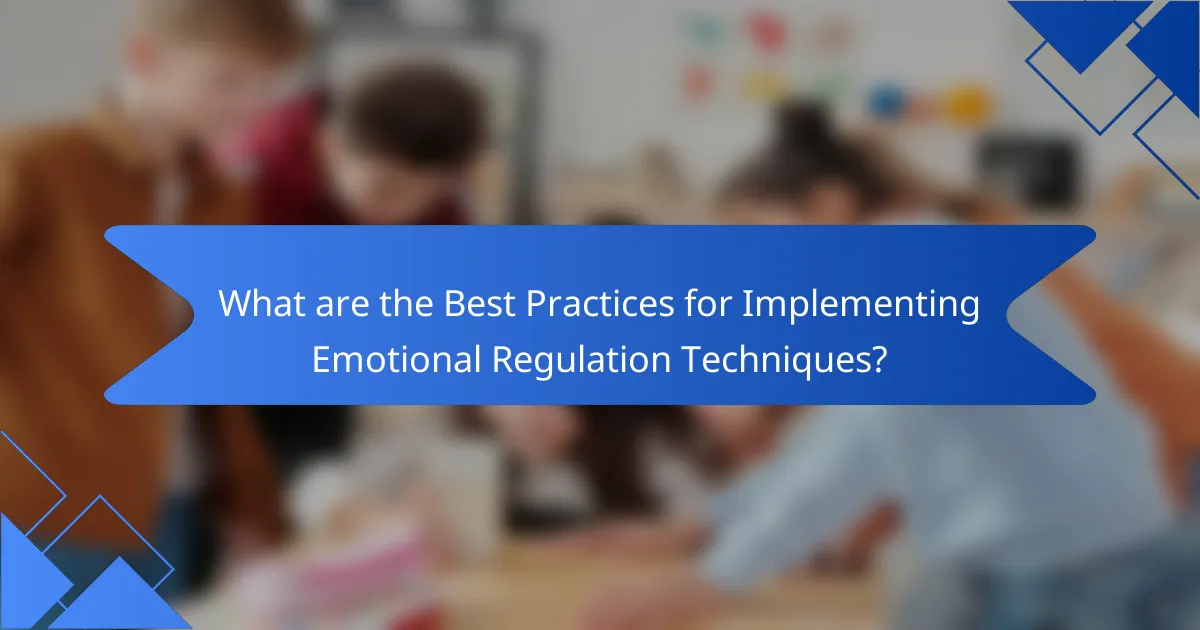
What are the Best Practices for Implementing Emotional Regulation Techniques?
To implement emotional regulation techniques effectively, athletes should focus on consistent practice, self-awareness, and adaptability. Regular training in mindfulness can enhance focus and resilience. Techniques like deep breathing and visualization help manage stress during competition. Journaling emotions aids in identifying triggers, while seeking feedback fosters growth. Emphasizing mental rehearsal builds confidence in performance under pressure.
What common mistakes should athletes avoid when practicing these techniques?
Athletes should avoid several common mistakes when practicing emotional regulation techniques. Focusing too much on outcomes rather than the process can hinder performance. Neglecting to personalize techniques to fit individual needs may lead to ineffective results. Overlooking the importance of consistent practice can create gaps in skill development. Additionally, failing to integrate techniques into training routines can limit their effectiveness under pressure.
How can athletes create a personalized emotional regulation plan?
Athletes can create a personalized emotional regulation plan by identifying specific emotional triggers and implementing tailored techniques. Start by assessing emotional responses during training and competition. Incorporate techniques like mindfulness, visualization, and breathing exercises. Regularly evaluate the plan’s effectiveness and adjust as needed. Engaging with a sports psychologist can enhance this process, providing expert guidance and support.
What expert insights can enhance emotional regulation strategies?
Expert insights can significantly enhance emotional regulation strategies for athletes. Techniques such as mindfulness, cognitive restructuring, and visualization are effective. Mindfulness helps athletes stay present, reducing anxiety and improving focus. Cognitive restructuring allows athletes to alter negative thought patterns, fostering resilience. Visualization aids in preparing mentally for high-pressure situations, enhancing performance. Incorporating these strategies leads to better emotional control and overall athletic success.
